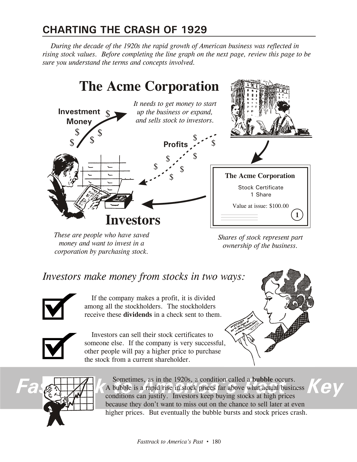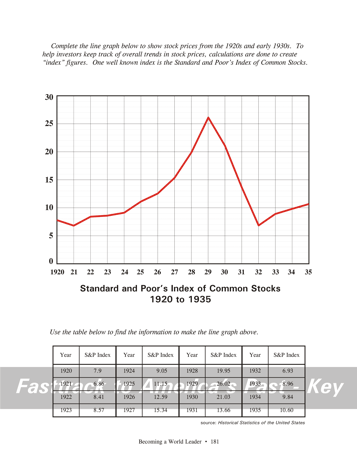| Fasttrack
to America's Past Teacher Key |
|
| Fasttrack
to America's Past Teacher Key |
|
 Page 180  Page 181 |
Pages 180
& 181 - Charting the Crash of 1929 The graphics and text, page 180 This page gives a graphic explanation of the
relation between
investors and corporations that issue stock. Students
should start at the top, where the fictional "Acme Products
Corporation"
is described as needing money to start or expand a business. Students should understand why this is an
important financial
system for creating progress. It allows people with good business
ideas but not enough money to get together with people who have extra
money
but no business plans of their own. The bottom half of the page explains how investors make money from their investments. It shows a woman receiving a dividend check - her share of the profits of a company she owns stock in. It also explains that investors can sell their stock to other investors. Such sales make up most of the action in the stock market. Making the chart, page 181 Students will need a color pencil to complete the line graph on this page. Red is a good choice.Students should study the table, then neatly place dots for the data and connect the dots with straight lines. What the chart shows The chart shows a steady run-up of stock prices during the 1920s after a slight dip early in the decade. During the last few years of the 1920s, the index of stock prices shows a pattern of investment often called a "bubble." That means investors were buying shares of stock at prices far higher than business conditions could really justify. Bubbles are driven by a "get rich quick" stock buying frenzy. Investors keep buying shares at higher and higher prices, because they think they will be able to sell later at an even higher price. But at some point the bubble breaks. That happened in 1929, and the chart shows the crash of stock prices that resulted. Keep in mind that this is a year by year chart, not a month by month or day by day chart. If a student asks why the drop appears to start at the beginning of 1929, instead of in October or November of that year, point out that the data for 1929 is for the full year. A much more detailed chart would have to be made to show month by month changes in the stock index. |
|
Copyright Notice
Copyright 2018 by David Burns. All rights reserved. Illustrations and reading selections appearing in this work are taken from sources in the public domain and from private collections used by permission. Sources include: the Dover Pictorial Archive, the Library of Congress, The National Archives, The Hart Publishing Co., Corel Corporation and its licensors, Nova Development Corporation and its licensors, and others. Maps were created or adapted by the author using reference maps from the United States Geological Survey and Cartesia Software. Please see the home page for this title for more information. |